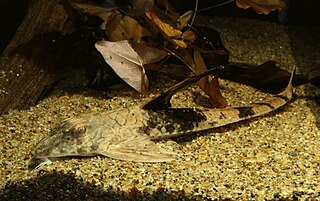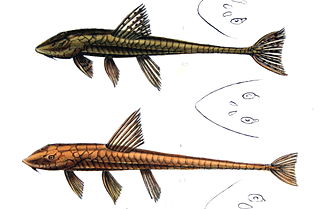
Loricariidae is the largest family of catfish, with 92 genera and just over 680 species. Loricariids originate from freshwater habitats of Costa Rica, Panama, and tropical and subtropical South America. These fish are noted for the bony plates covering their bodies and their suckermouths. Several genera are sold as "plecos", notably the suckermouth catfish, Hypostomus plecostomus, and are popular as aquarium fish.

Otocinclus is a genus of catfish in the family Loricariidae native to South America, commonly known as "dwarf suckers" or "otos". This genus, like other loricariids, is characterized by rows of armour plating covering the body, as well as the underslung suckermouth. They are generally small in size; O. tapirape is the smallest of the species (2.4 cm), while O. flexilis is the biggest (5.5 cm). These species have adaptations that allow them to breathe air. A duct forms at the junction between the esophagus and the stomach and expands into an enlarged, ring-like diverticulum, characteristic of this genus, which allows air-breathing. Otocinclus are popular aquarium fish, and they are often purchased as algae eaters. It is difficult to breed them in captivity, and only wild caught Otocinclus are available to hobbyists. This genus is widely distributed east of the Andes of South America, throughout the lowlands from northern Venezuela to northern Argentina, but are generally absent from the Amazon and the Orinoco lowlands.

Trichomycteridae is a family of catfishes commonly known as pencil catfishes or parasitic catfishes. This family includes the candiru fish, feared by some people for its alleged habit of entering into the urethra of humans. They are one of the few parasitic chordates. Another species is the life monsefuano which was important to the Moche culture and still an important part of Peruvian cuisine.

Rineloricaria is a genus of freshwater tropical catfish belonging to the family Loricariidae. They are commonly called whiptail catfish because of the long filament that grows out of the tip of the caudal fin that is characteristic of the genus. With the exception of R. altipinnis from Panama, they are native to the rivers of northern and central South America. Some species are regularly seen in the aquarium trade.
Acestridium colombiense is a species of armored catfish endemic to Colombia. It is only known from the Inírida River, Guainía Department in the east of Colombia.

Hemiancistrus is a genus of suckermouth armored catfishes. These species are native to South America. The taxonomy of this genus is complex and unclear, and major work has to be done. Many of these fish are popular aquarium fish.

Farlowella is a genus of fish in the family Loricariidae native to South America. This genus is broadly distributed in Amazon, Orinoco, Paraná and coastal rivers of the Guyana Shield. It is absent from the Pacific slope of the Andes and from the coastal rivers of the Brazilian Shield. Many of these species are kept in aquariums. This genus has a unique body shape that resembles a thin stick of wood. The body is slender and elongate, often with a pronounced rostrum and a brownish color with two lateral dark stripes beginning at the tip of the rostrum, passing over the eyes and ending at the tail, which are periodically interrupted on the caudal peduncle.
Rhadinoloricaria macromystax is a species of catfish in the family Loricariidae and the genus Rhadinoloricaria. The genus was monotypic until 2020, when a new species, R. stewarti, was described.
Otothyropsis is a genus of armored catfishes native to South America.

The Hypoptopomatinae are a subfamily of catfishes of the family Loricariidae, composed of 17 genera and approximately 80 species. This subfamily represents about one-tenth of all loricariid species.
Hisonotus is a genus of armored catfishes native to South America. Species of Hisonotus and Curculionichthys are the only representatives of the subfamily Otothyrinae having serrae on the posterior edge of the pectoral fin spine. These species are small fishes, generally found in small fast flowing streams, where they grasp to the branches and leaves of aquatic or subaquatic plants. The species of this genus mostly occur in Atlantic coastal streams of southern Brazil and the Paraguay-Paraná system of southern South America. They are also distributed in the Río de La Plata basin and coastal rivers of southeastern Brazil.
Microlepidogaster is a genus of armored catfishes native to South America.

Loricariichthys is a genus of catfishes of the family Loricariidae.
Harttia is a genus of armored catfishes native to South America.
Pareiorhaphis is a genus of catfish in the family Loricariidae native to South America. This genus can be readily distinguished from other neoplecostomines by the unique combination of having fleshy lobes on lateral margins of head ornamented with hypertrophied odontodes on nuptial males, caudal peduncle ovoid in cross section, abdomen usually naked, dorsal fin spinelet ovoid and adipose fin usually present. The color pattern is usually dark brown and mottled with the abdomen white. Most species in to Pareiorhaphis were originally described in Hemipsilichthys. In 1918, Alípio de Miranda-Ribeiro proposed the new genus Pareiorhaphis. Whether Pareiorhaphis is monophyletic or not is currently unknown.

Loricaria is a genus of armored catfish native to South America.

Parotocinclus is a genus of fish in the family Loricariidae native to South America. This genus is distributed through almost all hydrographic systems in South America from the Guyana Shield drainages and Amazon Shield tributaries to the coastal drainages of eastern and southeastern Brazil, including the rio São Francisco basin. Most species have the caudal peduncle oval in cross section. It has been found that Characidium species may interact with P. maculicauda. The small Characidium will follow grazing P. maculicauda, which release particulate matter dislodged from the catfish's foraging.

Chaetostoma, also known as the bristlemouth catfish, is a genus of suckermouth armored catfishes native to South America with one species, C. fischeri, extending into Panama. Most species inhabit flowing rivers in the lower Andes and its foothills. Some species are kept in unheated aquaria.
Acestridium dichromum is a species of armored catfish in the genus Acestridium. It is endemic to Venezuela, where it can be found in the upper Orinoco and Negro basins.
Acestridium martini is a species of armored catfish in the genus Acestridium. It is native to the upper Orinoco and Negro river basins in South America.









